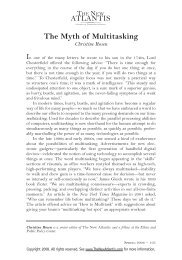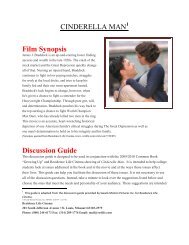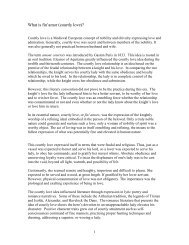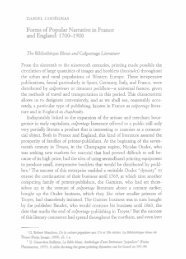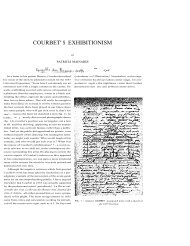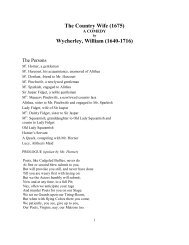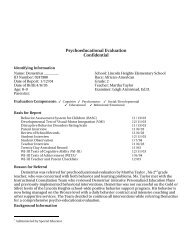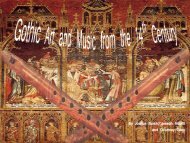(E)Merging Identities: The Dynamics of Female Friendship in ...
(E)Merging Identities: The Dynamics of Female Friendship in ...
(E)Merging Identities: The Dynamics of Female Friendship in ...
You also want an ePaper? Increase the reach of your titles
YUMPU automatically turns print PDFs into web optimized ePapers that Google loves.
414 Abel <strong>Female</strong> <strong>Friendship</strong><br />
and are shaped by the contemporary female literary imag<strong>in</strong>ation." have<br />
selected for close analysis recent novels that explore women's relatibnships<br />
as a serious and central issue <strong>in</strong> a variety <strong>of</strong> cultural contexts:<br />
Doris Less<strong>in</strong>g's <strong>The</strong> Four-gated City and <strong>The</strong> Golden Notebook, Christa<br />
Wolf's <strong>The</strong> Quest for Christa T., Ruth Prawer Jhabvala's Heat and Dust, and<br />
Toni Morrison's Sula. I have deliberately chosen to call attention to less<br />
familiar works that reveal the psychological underp<strong>in</strong>n<strong>in</strong>gs <strong>of</strong> female<br />
friendship rather than to works that display a primarily ironic attitude<br />
toward friendship, such as Fay Weldon's <strong>Female</strong> Friends and Joan Didion's<br />
<strong>The</strong> Book <strong>of</strong> Common Prayer, or to works that use friendship largely<br />
as a device for represent<strong>in</strong>g alternative female life choices, as do Mary<br />
McCarthy's <strong>The</strong> Group, Marge Piercy's Small Changes, and Paule Marshall's<br />
"Reena."3 <strong>The</strong> broadest implications <strong>of</strong> this analysis suggest a l<strong>in</strong>k<br />
between a characteristically fem<strong>in</strong><strong>in</strong>e response to same-sex relationships<br />
and the particular orientation <strong>of</strong> much contemporary psychoanalytic<br />
and literary theory. <strong>Female</strong> bond<strong>in</strong>g exemplifies a mode <strong>of</strong> relational<br />
self-def<strong>in</strong>ition whose <strong>in</strong>creas<strong>in</strong>g prom<strong>in</strong>ence is evident <strong>in</strong> the revival <strong>of</strong><br />
psychoanalytic <strong>in</strong>terest <strong>in</strong> object-relations theory and <strong>in</strong> the dynamics <strong>of</strong><br />
transference and countertransference, as well as <strong>in</strong> the growth <strong>of</strong> literary<br />
emphasis on theories <strong>of</strong> <strong>in</strong>fluence and <strong>in</strong>tertextuality.<br />
<strong>Female</strong> friendship has become a trendy topic for filmmakers, but<br />
such recent films as <strong>The</strong> Turn<strong>in</strong>g Po<strong>in</strong>t, Girlfriends, Julia, and One S<strong>in</strong>gs, the<br />
l98O), Janet Todd provides a very thorough and illum<strong>in</strong>at<strong>in</strong>g analysis <strong>of</strong> female friendship<br />
<strong>in</strong> eighteenth-century English and French fiction; <strong>in</strong> Communities <strong>of</strong> Women: An Idea <strong>in</strong><br />
Fiction (Cambridge, Mass.: Harvard University Press, 1978), N<strong>in</strong>a Auerbach also addresses<br />
the question <strong>of</strong> female bond<strong>in</strong>g, but focuses on female communities rather than on <strong>in</strong>dividual<br />
friendships. <strong>The</strong> portrayal <strong>of</strong> female relationships by male novelists has been<br />
analyzed by Lillian Faderman <strong>in</strong> "<strong>Female</strong> Same-Sex Relationships <strong>in</strong> Novels by Henry<br />
Wadsworth Longfellow, Oliver Wendell Holmes and Henry James," New England Quarterly<br />
51 (September 1978): 30S32.<br />
2. S<strong>in</strong>ce the literary representation <strong>of</strong> psychological processes shifts <strong>in</strong> response to<br />
historical variables, I have limited this analysis to a sample <strong>of</strong> twentieth-century fiction by<br />
women. <strong>The</strong> conventions <strong>of</strong> n<strong>in</strong>eteenth-century fiction tended to fit the portrayal <strong>of</strong> female<br />
friendship <strong>in</strong>to the narrative progression toward the marriage <strong>of</strong> the hero<strong>in</strong>e(s), limit<strong>in</strong>g<br />
the potential scope and depth <strong>of</strong> the female relationship, while real geographic and social<br />
limitations on the pool <strong>of</strong> available friends shaped these friendships and their literary<br />
portraits <strong>in</strong> ways different from their twentieth-century counterparts.<br />
3. <strong>The</strong> last three examples conform to a traditional novelistic use <strong>of</strong> female<br />
friendship, a use that predom<strong>in</strong>ates <strong>in</strong> some <strong>of</strong> the major turn-<strong>of</strong>-the-century novels by<br />
American women. In these works the protagonist's relation to her friends is less significant<br />
than the rather schematic options these friends <strong>of</strong>ten represent. Thus the hero<strong>in</strong>e <strong>of</strong> Kate<br />
Chop<strong>in</strong>'s <strong>The</strong> Awaken<strong>in</strong>g is neatly situated between two friends who represent the s<strong>in</strong>gle<br />
artist and the "mother-woman"; the hero<strong>in</strong>e <strong>of</strong> Edith Wharton's <strong>The</strong> House <strong>of</strong> Mzrth stands<br />
similarly immobilized between the unpalatable drabness <strong>of</strong> the virtuous Gertie Farish and<br />
the unscrupulous self-aggrandizement <strong>of</strong> the glamorous Bertha Dorset. <strong>The</strong> twentiethcentury<br />
works which I discuss privilege the dynamics <strong>of</strong> the friends' <strong>in</strong>teractions rather<br />
than the static function <strong>of</strong> emblematicsecondary characters.




